Group instrumental classes start with the fundamentals of music, notes and instruments for the youngest explorers in steps 1-4. Older students may survey instruments or practice with others in small groups--all while having fun!
- Step #1: Family Class (Pre-EMA)
- Step #2: Early Music Awareness I
- Step #3: Early Music Awareness II
- Step #4: Early Music Awareness III (Instrument Prep)
- Pre-keyboard: Ages 5-6
- Option #1: Instrument Survey II
- Option #2: Instrumental Ensembles
Step # 1: EMA FAMILY CLASS
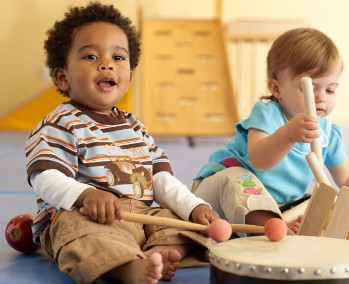 Pre-Early Music Awareness (EMA): Ages 6-36 months
Pre-Early Music Awareness (EMA): Ages 6-36 months
If your child is between 6 to 36 months or under 5 years and needs to be with you in a class, you'll want to join one of our toddler-parent participation classes. These classes are a wonderful opportunity for a special time of bonding with your child in a warm, encouraging environment.
In addition to singing, movement and rhythm games, classes include symphonic and ethnic instrument exploration in which parents and children have the opportunity to handle and play real instruments and learn about notes in a fun 30-minute format. EMA Family classes are limited to six families. (Siblings enrolled in other classes attend at no charge.)
See Current Group Schedule to find EMA Family classes
Step # 2: EARLY MUSIC AWARENESSTM
 Level I: Ages 3-5 & 4-6
Level I: Ages 3-5 & 4-6
Early Music Awareness (EMA) is our trademark class! Your young child (3 to 6 years) will gain a sense of independence by being a part of a small group of children (no more than 8 to a class) where she will be able to receive personal attention and have her individuality acknowledged and honored. In addition children are prepared for future instrumental instruction by learning to read music and try potential instruments in an active, fun and exciting environment. Learn more about EMATM
Even as young as three years old, your child will be proud of her ability to identify notes and their values. And she will be excited to share with you the handouts she'll receive with every lesson.
View Current EMA Schedules and Request a FREE Trial Class
Step # 3: EARLY MUSIC AWARENESS TM : E.M.A.
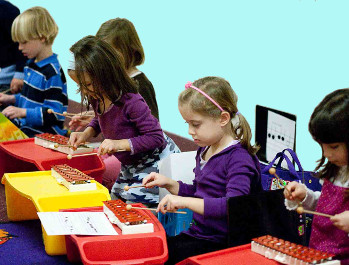 Level II: Ages 5.5-7
Level II: Ages 5.5-7
Available as an ongoing class, the next step for growing students may be EMA II. In this class, the theory and instrument exploration sections of EMA are combined in each class to allow students ages 5.5-7 to focus on specific instruments. In 3-4 week segments, they will learn to play actual songs on keyboard, flutophone, deskbells, ukulele and/or glockenspiel as they continue to learn to read music.
In addition they explore instruments like violin, guitar, trumpet and drums that they might choose to play someday. Carried over from EMA I, plenty of rhythm games, movement and singing activities keep the class moving in this older-child version of Early Music Awareness
Step # 4: EARLY MUSIC AWARENESS TM

Level III: (formerly called Instrument Prep= Instrument Survey & Keyboard Overview) Ages 6-8
16 weeks offered in 2 sessions. Offered three times per year, the primary goal of this class is to give students experience with size-appropriate instruments and to help them determine the best fit. Students learn to read music and enjoy the opportunity to apply their learning to keyboards, learning to play simple songs.
This classe is divided into two sections: (which may be taken separately)
SECTION #1: Instrument Survey: Explore the 8-10 instruments that are size appropriate including (but not limited to): Violin, Cello, Drums, Glockenspiel (like a keyboard played with mallets), Flute, Recorder, Guitar, Ukulele, and piano/keyboard.
SECTION #2: Keyboard Overview: Learn keyboard basics: (geography, music reading) and play simple songs to help prepare for private lessons. Find out more about Instrument Prep and see scheduled classes.
Pre-Keyboard: Ages 5-6
This is a simplified version of the EMA III (part 2) Keyboard overview and runs 8 weeks to offers a basics overview of keyboard for kids who are not quite developmentally ready for the EMA III course described below. We designed it to be a more light-hearted, low key approach to keyboard. This allows students to explore the basics even if their fingers are not quite strong enough or their attention is not quite ready for private lessons or EMA III. It is perfect for pre-readers and is modified to address slightly younger students while still fitting the description of EMA III below.
Option # 1: INSTRUMENT SURVEY II
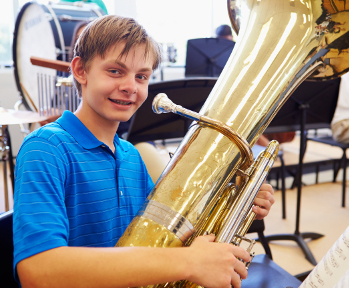 Instrument Survey Level II: Ages 9 & up
Instrument Survey Level II: Ages 9 & up
Instruments that are too large or difficult for younger children become available in about the 4th grade. In addition to the instruments listed in Step #4 Instrument Prep, older students may consider: trumpet, trombone, French horn, tuba, clarinet, saxophone, bassoon, viola and other larger instruments.
Most level II surveys are arranged in a 1-on-1 private lesson and customized to interest of the student. The session may be from 2-8 weeks depending on the number of instruments and the students' previous music learning experience. Note: Our Instrumental Path teachers are trained to help students handle and explore these instruments; however, at any given time, we may not have specialists available on every specific instrument. We are happy to refer you if we don't!
Option #2: KEYBOARD ENSEMBLE & STRING ENSEMBLES
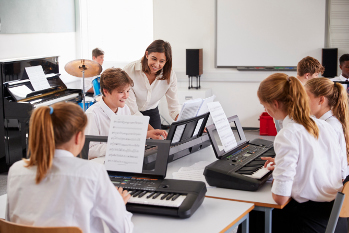 Keyboard or Strings: Ages 9 & up
Keyboard or Strings: Ages 9 & up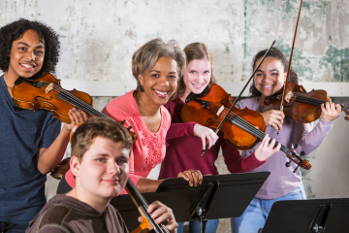
Keyboard students learn theory as a group, and while remaining students practice with headphones, the instructor works with each child individually for about 10 minutes out of the 45-minute class.
String players may meet quarterly for ensemble performance preparation.
For information about private instrumental or vocal lessons, read more on the private lessons options page.




